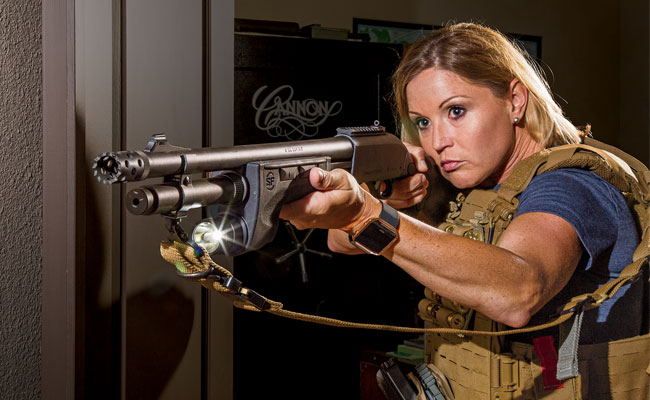
To be used effectively, the shotgun must be mastered.
Is the pump gun still relevant in today’s home-defense toolbox? As an unabashed lover of both flavors of scattergun, my answer might be a little surprising. I think that most people should use something else. To be used effectively, the shotgun must be mastered. It’s not a sloppy tool that merely needs to be pointed in the general direction of the bad guy, nor is it a magical talisman that will send a bad guy running at the very sound of its action being cycled (in the case of a pump action). It has prohibitive recoil, it is slow to reload, its distance is limited and it’s heavy.
While all these things are true, I still love it. You know why? Because at typical home-defense distances, there is nothing that hits like a load of 12-gauge buckshot. One press and the target gets nine to 12 projectiles at once. That’s stopping power.
Most people won’t put in the work to master the shotgun, and for them, this isn’t the right tool. You’ll be much better off with a pistol or carbine. For those of you who want to run the tube, read and heed.
CHOOSE
The first thing you need to do is figure out if you want to run a pump or a semiautomatic. Yes, a semiauto is faster. That said, there are few people who can run either style fast enough to take full advantage of the semiauto’s speed advantage. To test this hypothesis, I recently put myself one-on-one against another shooter for some drills, including multiple target drills. I was armed with my Mossberg 590 A1, and he was armed with a Benelli M4. We are both proficient shotgunners and, as I suspected, time differences were negligible. I won a few, he won a few, and we were really close every single time. While a great shooter with light loads can take advantage of the speed difference, I don’t think that it makes a significant difference in home-defense scenarios. Don’t get me wrong, if you’re willing to put in the work, then nothing says “let’s party” like a 12-gauge semiauto. Just be realistic and understand the limitations.
Reloading during a home-defense scenario rarely happens. In fact, it happens so infrequently that it is statistically insignificant. Most defensive uses of the shotgun — or any gun — result in fewer than five rounds fired. Of course there are outliers, and while reloading practice is a necessary skill “just in case,” the fact that a weapon for home defense takes longer to reload than others isn’t necessarily a reason to discount it. Home defense is a different mission than military and law enforcement (LE) use, so training with your home-defense firearm should reflect that. Target identification, coming up on target, getting a shot off quickly and controlling recoil should be emphasized. Some of the running and gunning and multiple threat engagement stuff that gets

